AMD Radeon 6790 Review - Benchmarking
System Specs
Virtually all testing on the Radeon HD 6800, 6900 and 5000 Series was done on using the 6900 release drivers. I re-tested all previous cards (HD 6800 and HD 5000 Series) on these drivers, with 16:9 1080p panels. The only exceptions are the HD 6990 and the HD 6790, which each used their release drivers. Prior to loading the new drivers, I performed a removal of all previous drivers with Driver Sweeper.
- Windows 7
- EVGA X58 Tri-SLI Motherboard
- Intel i7 920 at 4x2.67GHz
- 12GB G.Skill DDR3 RAM
- 2x Samsung 320GB T-Series HDD (one for the OS and games; one for swap file and FRAPS)
- LG Super Multi Blu (HD-DVD/Blu-Ray Player)
- Onboard audio
- Corsair HX1000
- My Open PC Doma Pro PCI Case
- Logitch K340 Keyboard & Performance MX Mouse
- Ergotech Heavy Duty Triple Desk Stand
- 5x Dell U2211H IPS 16:9 1920x1080 Displays
My test rig remains unchanged, except for a new case. For easier testing, I recently migrated to the Doma Pro PCI test bench from My Open PC (review on that coming soon).
Hardware Tested
I only have AMD hardware tested for comparison in this review. This is not for lack of wanting to test NVIDIA hardware in Surround, but NVIDIA has not yet decided to support the WSGF with hardware for review and benchmarking. Considering that the WSGF is a hobby that just supports itself, I cannot justify spending the money needed to test NVIDIA cards.
Most of my time is spent working on the site (or other projects), and much of my "play time" is spent benchmarking. Cards would basically only be used for testing, and I cannot reconcile purchasing cards that would only be used for testing. It's simply not a good ROI.
Resolutions Tested
I tested both 1600x900 and 1920x1080 in widescreen, as well as 4800x900 and 5760x1080 in 3x1-L Eyefinity. Additionally I tested in 5400x1920 and 4500x1600 for 5x1-P Eyefinity. This allows for comparison between panels in the 20" and 22" range, as well as performance improvements from dialing back the resolution on notch.
Games Tested
My game selection remains unchanged since the HD 6990 benchmarks.
- Aliens vs. Predators
- Battle Forge
- DiRT 2
- F1 2010
- Far Cry 2
- HAWX (only at 2xAA)
- Heaven 2 (DX9, DX10 & DX11)
- Just Cause 2
- Mafia II
- S.T.A.L.K.E.R. - Call of Pripyat Benchmark Tool
As always, all games are tested at max settings (unless otherwise noted), with 4xAA and 16xAF enabled.
Notes on Testing
In many areas, I am hitting a CPU limit in widescreen. In several instances the widescreen performance is hitting a wall at 100fps+. In some of these instances older cards appear to be outperforming newer cards by a couple fps. These minor differences are well within a margin of error, and should be considered identical performance.
Since I originally tested the 5800 series (well over a year ago), my system has gathered a certain amount of cruft due to games being installed and removed, and the video drivers being updated on a regular basis. While Windows 7 certainly handles "aging" much better than WinXP or Vista, this alone could account for the few fps difference (considering the difference is only a few percent variation).
Future Testing
I have updated my benchmarks suite as I mentioned in previous reviews. Additionally, I have retested all cards from the Radeon HD 5770 forward on the 10.12 drivers and 16:9 1080p panels. For stock benchmarking there isn't much left to do. The new Shogun 2 title will include three different benchmarks, and I will probably run everything through one or more of those.
In addition to that, I now have a 3D HDTV, and will be doing some reviewing and benchmarking of 3D PC gaming. There is an obvious impact when pushing 3x the pixels (and more FOV) with Eyefinity. What is the impact for rendering the same image twice (with only the original FOV)? We will know soon enough.
AMD Radeon 6790 Review - Aliens vs. Predator
Aliens vs. Predator (AvP) is an FPS title from Rebellion Studios. It allows players to take on the role of either an Alien, a Predator or a human space marine. While the title received mixed reviews, it is a DX11 graphics powerhouse that can bring many machines to their knees.
The demo follows a number of Alien creatures, and makes extensive use of shaders and tessellation. Hitting 60fps in Eyefinity is not possible on a stock Core i7-920 (at max quality settings in-game), even with the Radeon HD 6990 or Radeon HD 6970's in CFX. However, dropping to 3x1600x900 produces a noticeable increase in fps.
AvP basically requires 2GB for any Eyefinity setup. The demo basically fails to run on any 1GB card. The HD 6790 creeps along at 3x1600x900, but is certainly unplayable at "max" settings. The HD 6790 will hit 30fps on a single 1600x900 panel, even at max settings.

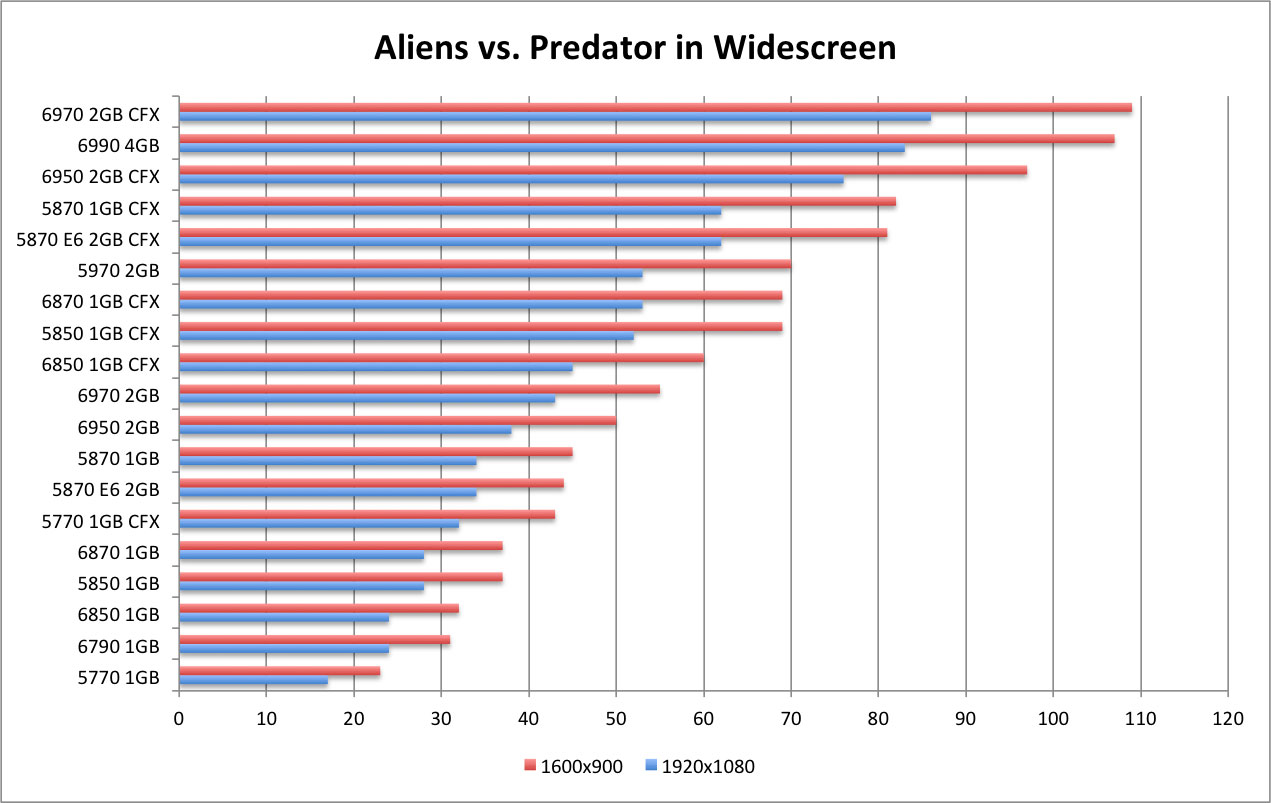
AMD Radeon 6790 Review - Battle Forge
Battle Forge is the free-to-play RTS from Electronic Arts. It offers a steampunk/fantasy RTS experience, where armies are build based on "decks" of cards similar to the Magic: The Gathering card game.
Battle Forge is one of AMD's spotlight (my terminology) games, as it offers both DX11 and proper Eyefinity support. The game offers a number of DX11 features, and a wealth of options for tuning performance. Specifically, Battle Forge uses DX11 and Shader Model 5.0 to compute HighDefinition Ambient Occlusion (HDAO). For our tests we maxed out all of the settings and forced DX11 through the config.xml file.
Very few of the cards in this range are taxed in widescreen. At max settings, all of the cards are breaking past 30fps. And, all of the CFX configurations are blowing past 60fps. Turn down a couple of settings and any current card should be able to hit 60fps.
The HD 6790 will run the Battle Forge demo in Eyefinity, though it isn't at a "playable" 30fps at max settings and the DX11 codepath. The card does push past 30fps in a single screen, and could reach 30fps with a reduction in settings.
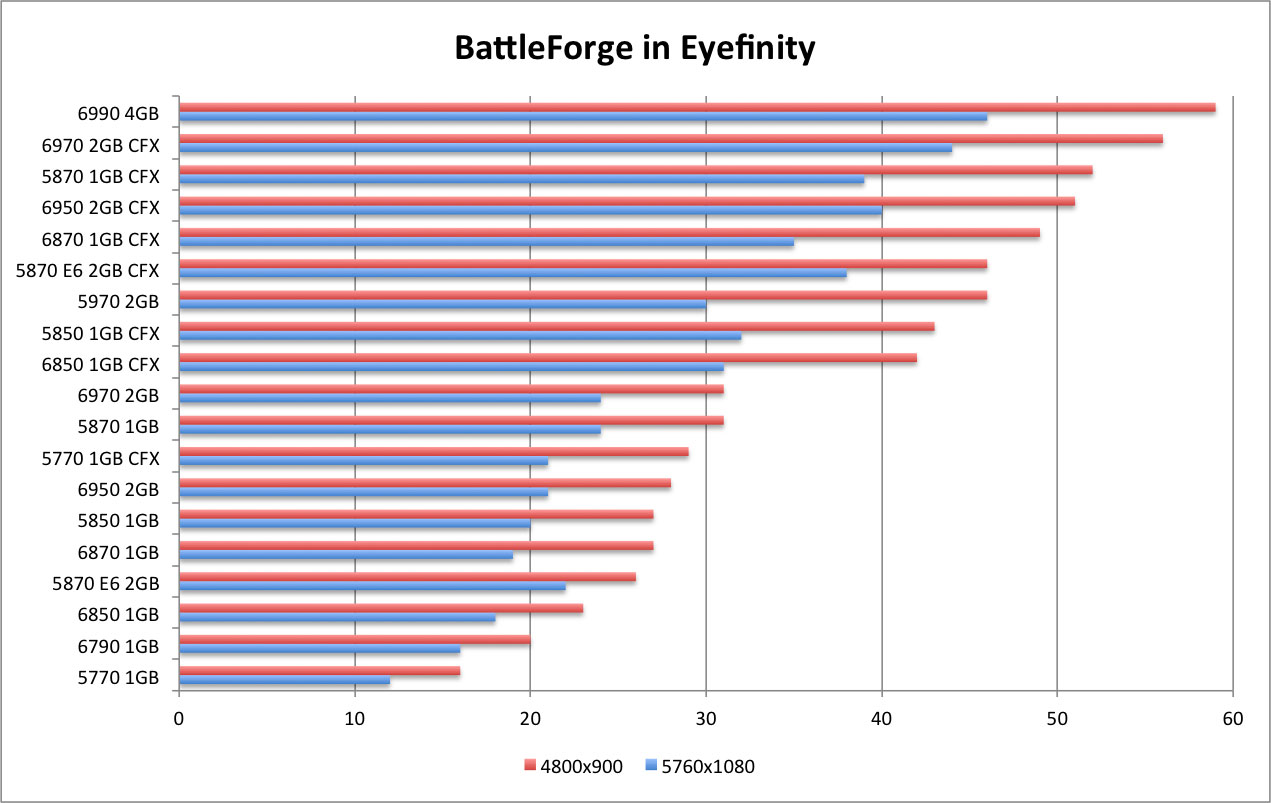
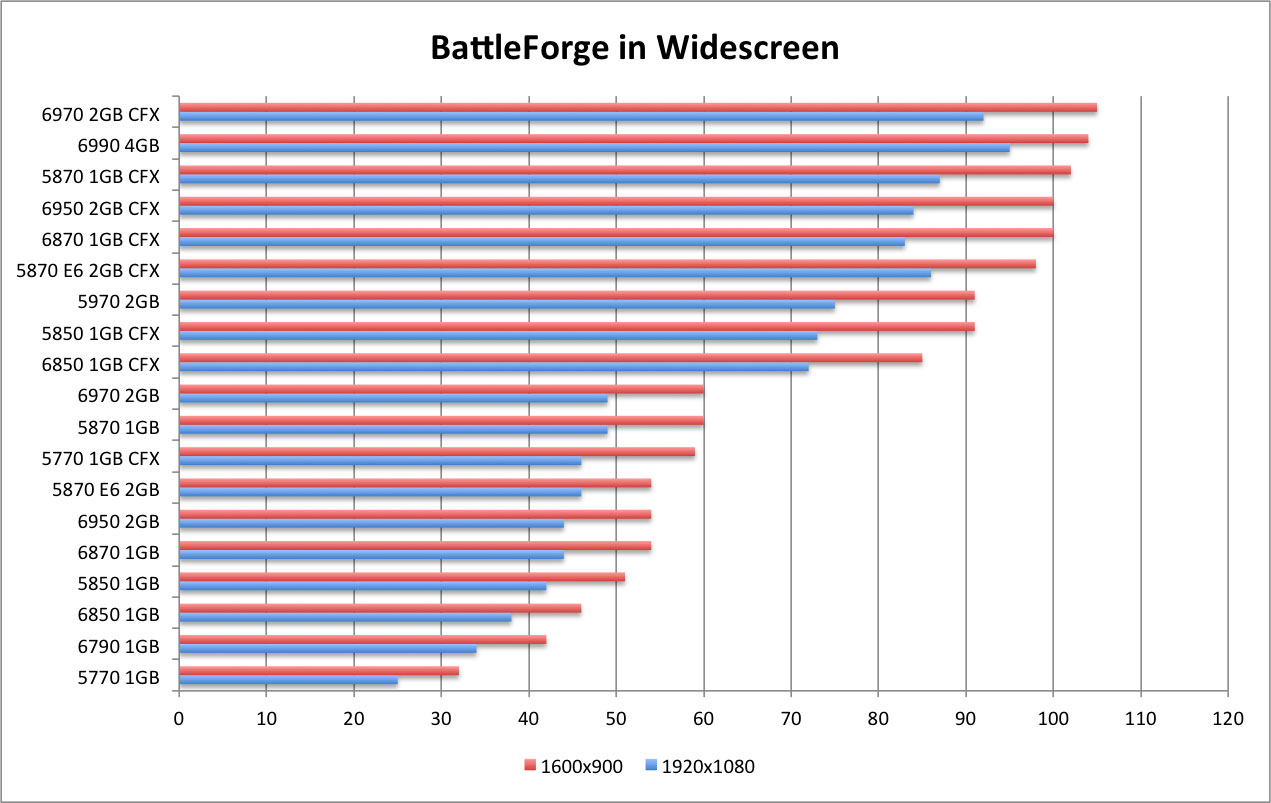
AMD Radeon 6790 Review - DiRT 2
Dirt 2 is the latest iteration of the Dirt rally racing series from Codemasters. Like Battle Forge, Dirt 2 is a spotlight game for AMD. Like Battle Forge it offers proper Hor+ gameplay in Eyefinity and DX11 support. Unless the user goes into the "hardware_settings_config.xml" file and forces DX9, Dirt 2 runs in DX11 mode. Unfortunately Dirt 2 does not offer a DX10 mode. This is unfortunate, as many games show improved performance when running in DX10 vs. DX9.
The true (noticeable) DX11 features come in to play based on the user settings in the in-game graphics options. Several key features are the "Hardware Tessellated Dynamic Water" (achieved through "Ultra" quality water), "Hardware Tessellated Dynamic Cloth" (achieved through "High" quality cloth), and DX11 Accelerated HDAO (through "High" quality HDAO).
The DX11 water and cloth offer more realistic geometry and movement. The DX11 water produces actual waves in deep puddles (as the player drives through), rather than simple "swirls" in the texture surface. The DX11 cloth offers more realistic ripples and waves in the cloth material over the DX9 version. On the other hand, the DX11 HD Ambient Occlusion (HDAO) offers an accelerated computation path.
DX11 doesn't necessarily provide earth-shaking changes to gameplay. But, it provides more realistic "movement" in the world's objects - cloth, water, grass, etc. While a DX9 or DX10 game is perfectly enjoyable, the DX11 technology offers better immersion by making the "little things" more lifelike. Additionally, it offers better computation paths through increased parallelism (and better computation paths for DX10), much like DX10 offered better performance (over DX9) in games such as Far Cry 2.
The HD 6790 cracks 60fps at 1600x900, with DX11 Ultra settings and 4xAA. It comes just shy in of 60fps at 1080p. It does hit 30fps in 3x1600x900 Eyefinity, again at DX11 Ultra and 4xAA.

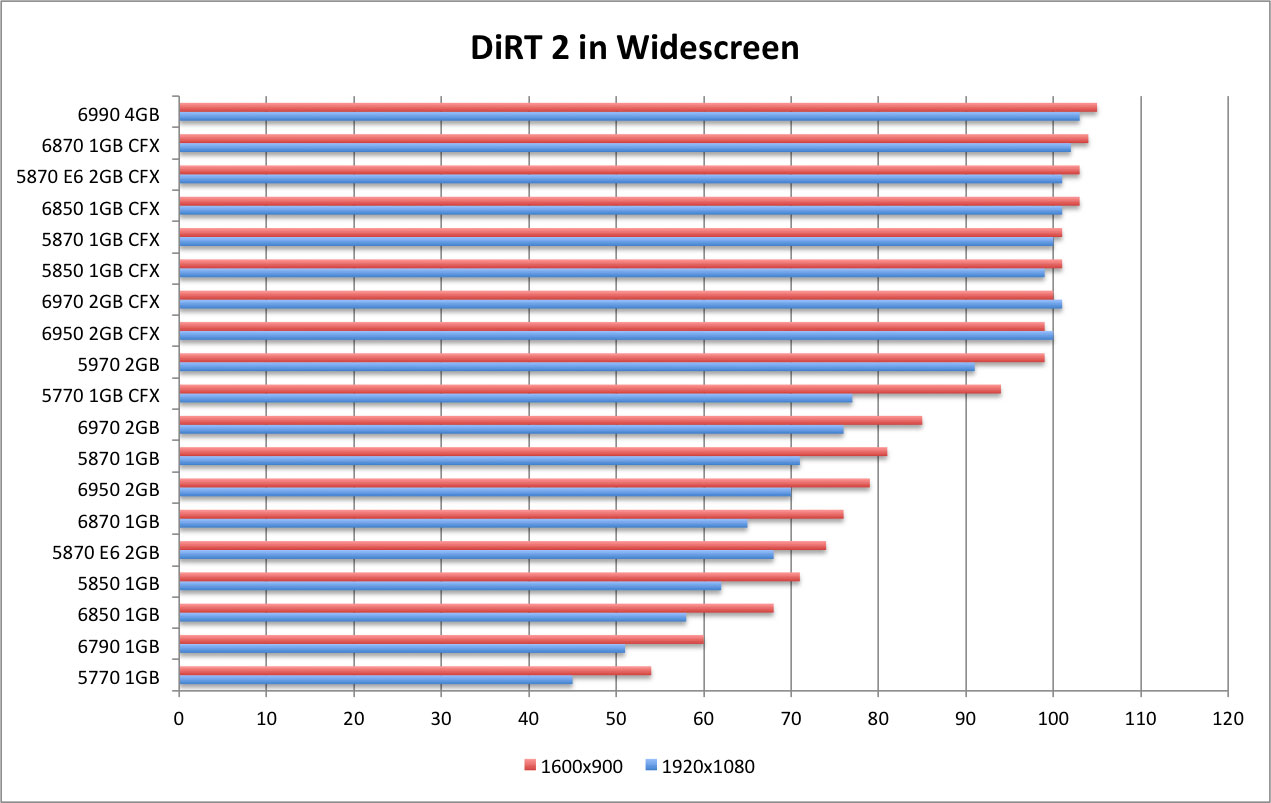
AMD Radeon 6790 Review - F1 2010
F1 (Formula 1) is a new racing title from Codemasters. Like their previous title (DiRT 2), F1 makes extensive usage of DX11 technology with cloth, fluid dynamics and tessellation. The title is much more strenuous on both single screen and Eyefinity, compared to DiRT 2.
At max settings the title hits a CPU cap (with a stock Core i7-920) of ~70fps on a single widescreen, with any pair of 6800 or 6900 series cards in CFX. Single 6900 series cards max out at just under 70fps.
A 2GB card is required for Eyefinity at 3x1920x1080p. 2GB cards in CFX max out at ~45fps, at both 3x1600x900 and 3x1920x1080. 1GB cards are playable at 3x1600x900, with the HD 6790 pulling having the fps of a 2GB CFX setup. In single screen, the HD 6790 crosses 30 fps at both 1920x1080 and 1600x900.
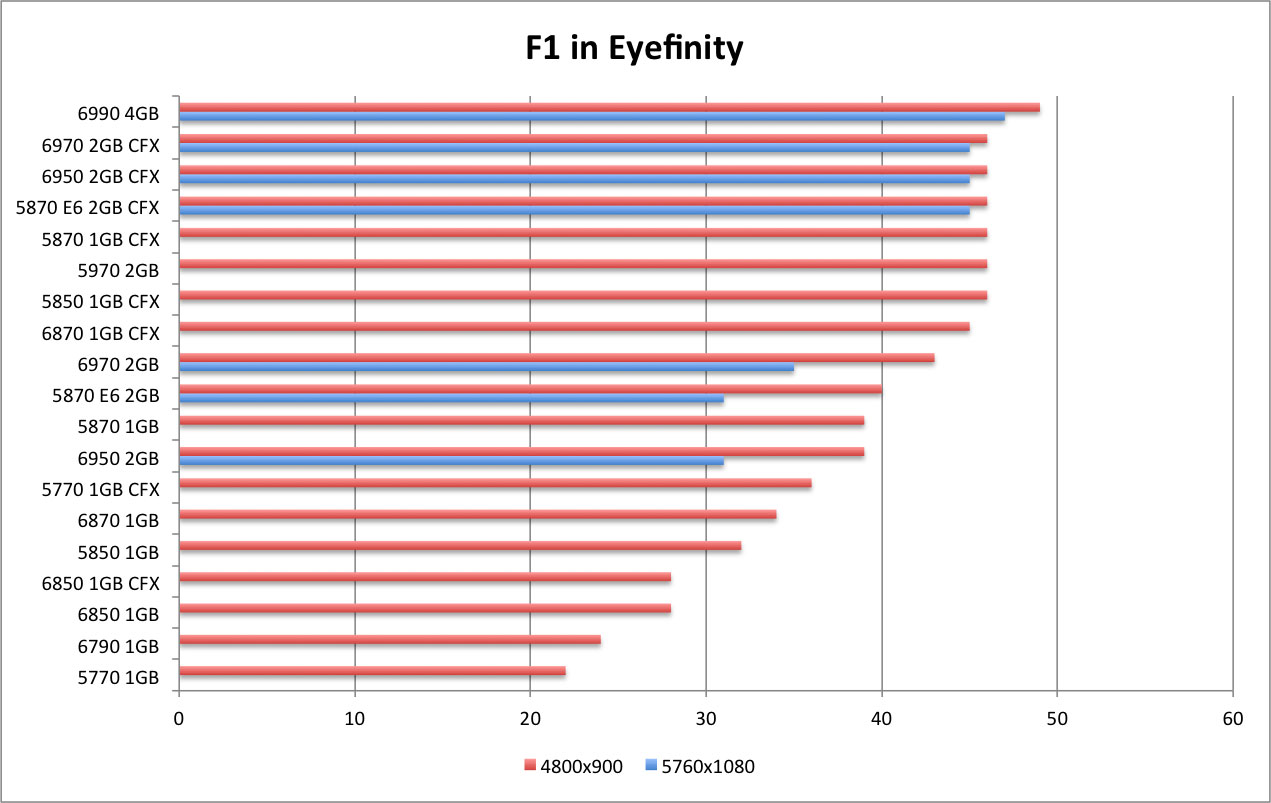
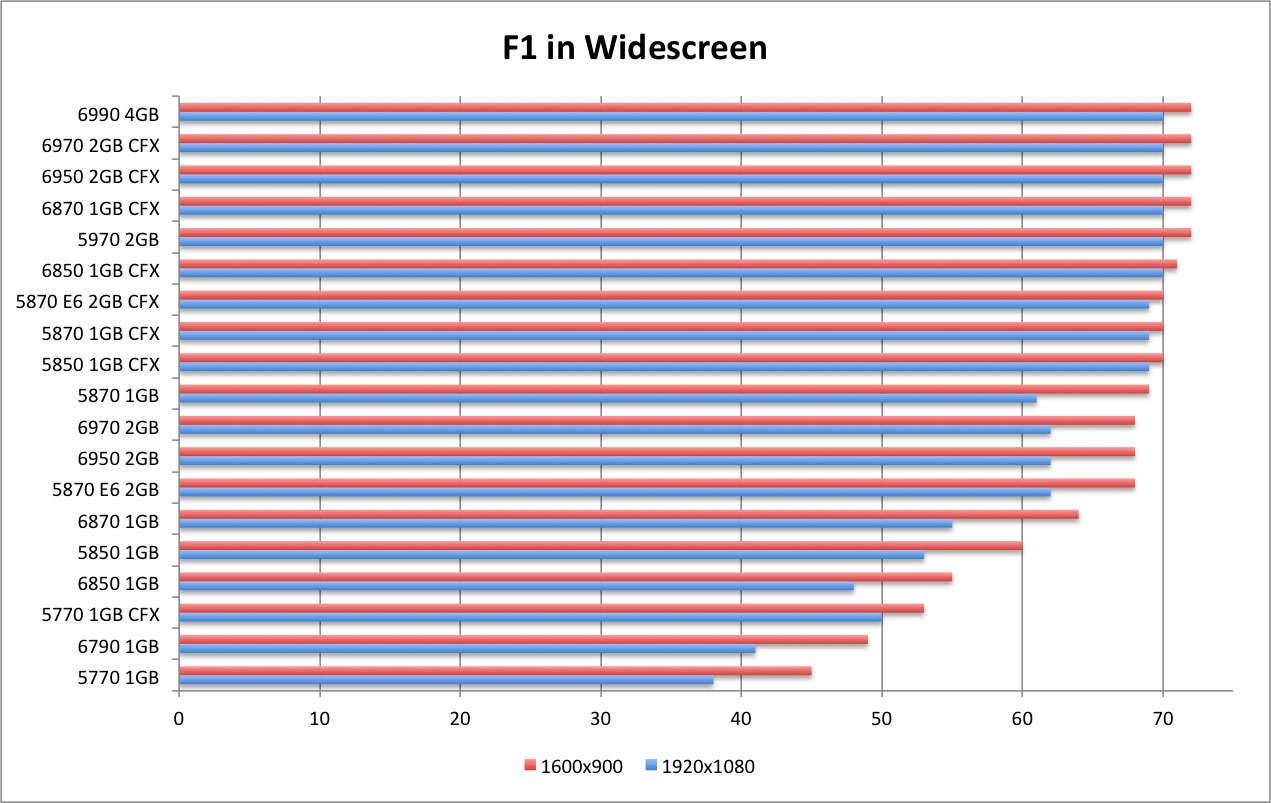
AMD Radeon 6790 Review - Far Cry 2
Far Cry 2 (and the whole Cry/Crysis series) has long been considered a system killer. If not a killer, then at least a good strong test. As always, we run our test at max settings with 4xAA. The benchmark tool within Far Cry 2 offers settings for High, Very High and Ultra. We chose Ultra with 4xAA.
While once a true system killer, Far Cry 2 shows that hardware catches up to software. All but the 5770 are hitting 60fps in widescreen (at max settings), and the CFX configurations are doubling that at a 120fps CPU wall.
Eyefinity does show a steady performance climb. The HD 6790 hits 60fps at 1600x900 and 30fps at 3x1600x900. Both of these are at 4xAA with Ultra settings and would look good stretched across a 1920x1080 panel. Upping to 1080p and 3x1080p drops the fps to just under the 60fps and 30fps marks.
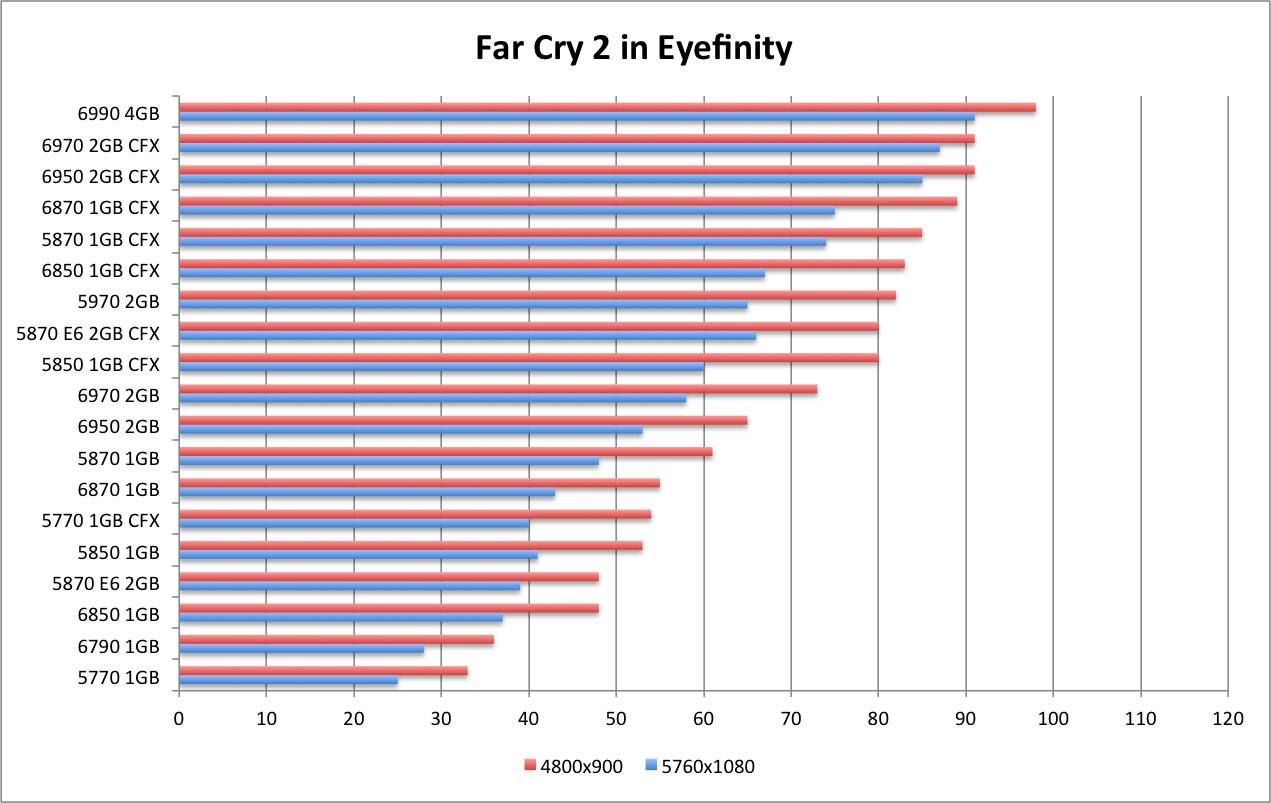
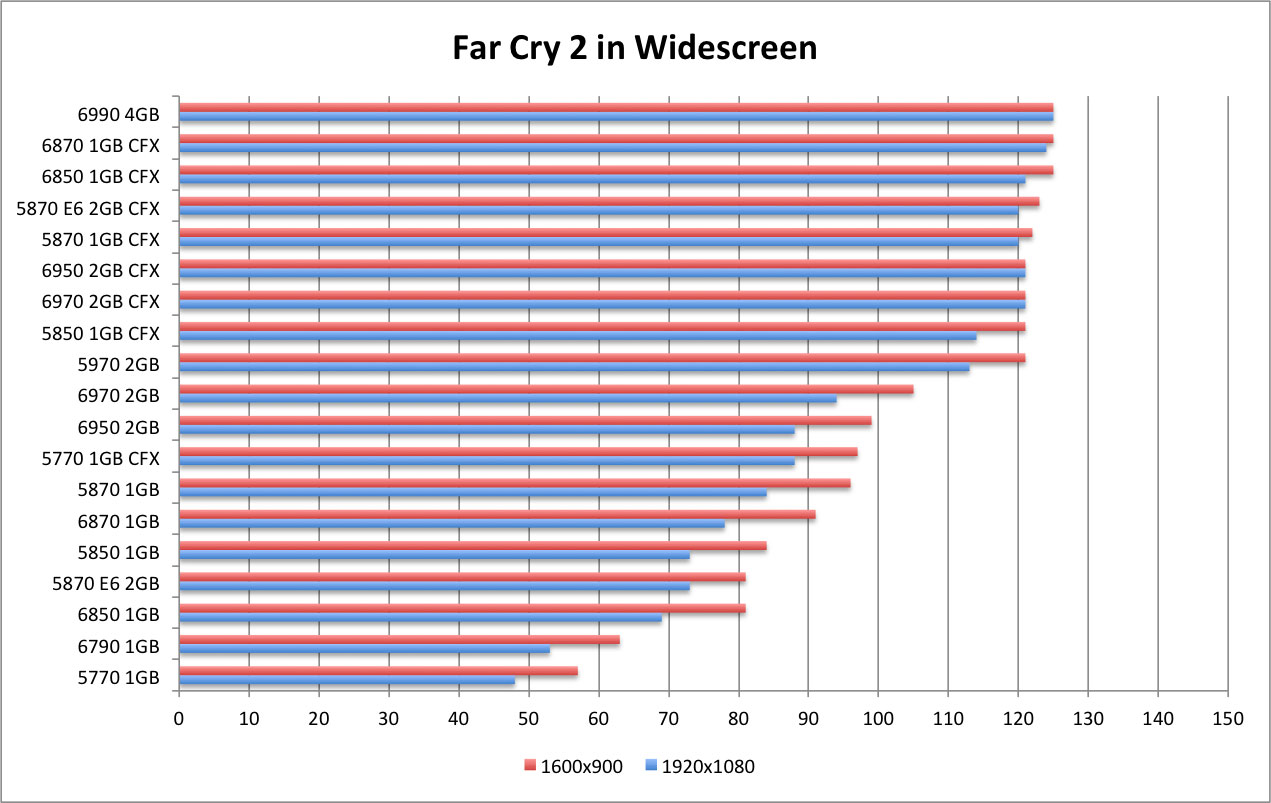
AMD Radeon 6790 Review - H.A.W.X.
H.A.W.X. is one last title that AMD has been showing off since the Radeon 5000 line launched. While the other titles are Hor+ and offer cutting-edge DX11 features, HAWX is quite the opposite. While it is a Hor+ title, it is only a DX10 title and runs quite well on a wide variety of hardware.
The well running and scalable title makes it a natural fit when showcasing both lower-end hardware pushing three panels, and high-end hardware pushing six panels. It also comes as no surprise that the additional VRAM largely goes unused, considering the title runs capably on lower hardware.
One note in the HAWX benchmark. Above 1920x1080 the game simply would not allow 4xAA. While the scores provide that the title could handle it, the option simply is not available. Though it isn't our norm, we chose to accept 2xAA so that we could get consistent readings across the spectrum of hardware.
The Radeon HD 6790 pulls 60fps at any single widescreen resolution, and 30fps at Eyefinity resolution. This is at max settings and 2xAA.

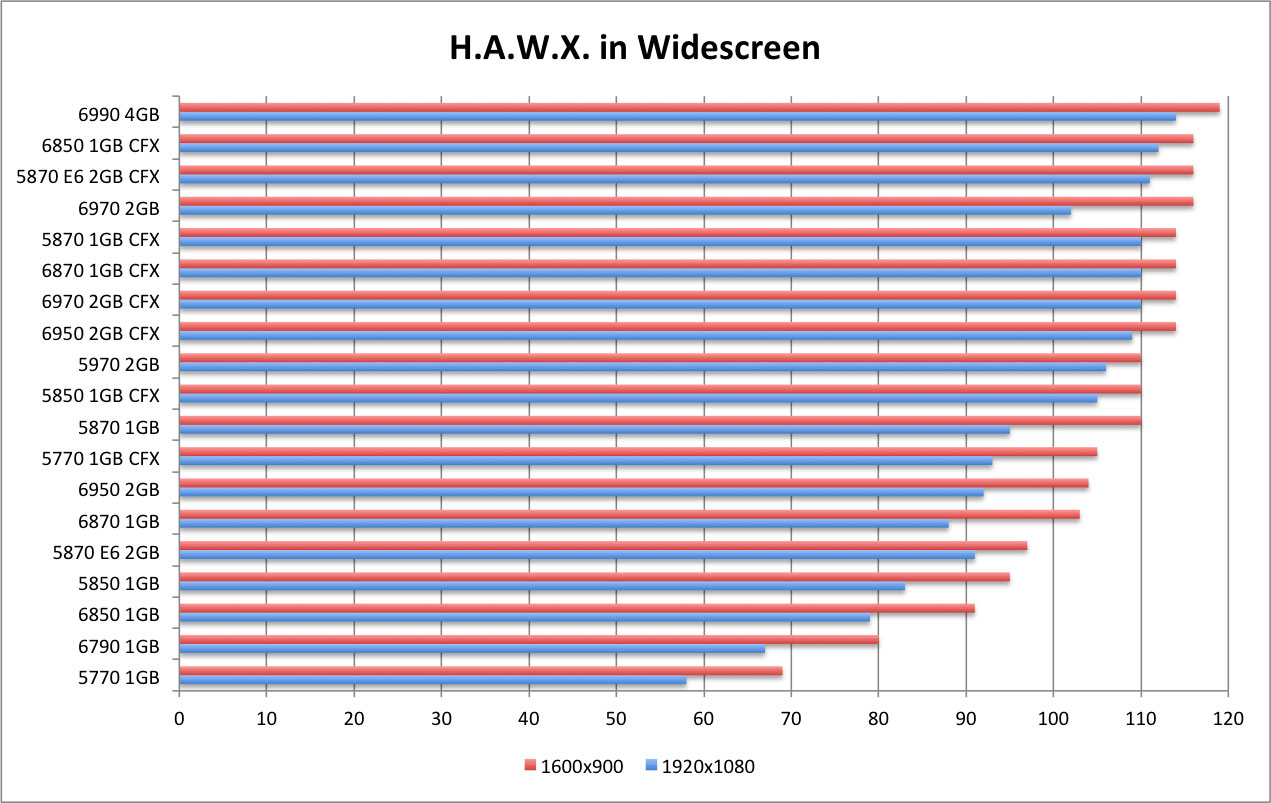
AMD Radeon 6790 Review - Heaven v2
The Unigine Heaven Demo is unique in that it is the only demo which allows for the following components in one package.
- Synthetic Demo (i.e., a demo designed to "test" a system)
- Comparable tests of DX9, DX10 and DX11
- Is Hor+ (rather than limited to a few predefined aspect ratios)
The ability to compare DX9, DX10 and DX11 in the same environment allows for the unique ability to see how the different cards perform across these different comparable environments. Tessellation was set at Normal Mode.
The updated 2nd version of the Heaven demo offers more segments and more options. DX9 and DX10 runs are no match for any single 6800 or 6900 series card, with only the single 6800 series falling below 60fps. The DX11 run in more demanding in a single widescreen, requiring a 6900 series in CFX to pass 60fps (and pass it by a good margin). Single 6900 series cards also pass 30fps at either 1600x900 or 1920x1080.
Eyefinity is an obvious strain on any configuration. A 2GB card is required for Eyefinity in DX10 or DX11. No combination of cards will hit 60fps in DX9, though the high end configurations come close.
The HD 6790 will hit 30fps in single screen configurations, though Eyefinity brings a serious blow to performance. With quality reductions you could hit "playable" framerates in Eyefinity.
The Heaven v2 Demo continues to be a powerhouse in bringing graphics cards to their knees. We have tested the Heaven v2 Benchmark in:
- DX9
- DX10
- DX11
AMD Radeon 6790 Review - Heaven DX9
The Unigine Heaven Demo is unique in that it is the only demo which allows for the following components in one package.
- Synthetic Demo (i.e., a demo designed to "test" a system)
- Comparable tests of DX9, DX10 and DX11
- Is Hor+ (rather than limited to a few predefined aspect ratios)
The ability to compare DX9, DX10 and DX11 in the same environment allows for the unique ability to see how the different cards perform across these different comparable environments. Tessellation was set at Normal Mode.
The updated 2nd version of the Heaven demo offers more segments and more options. DX9 and DX10 runs are no match for any single 6800 or 6900 series card, with only the single 6800 series falling below 60fps. The DX11 run in more demanding in a single widescreen, requiring a 6900 series in CFX to pass 60fps (and pass it by a good margin). Single 6900 series cards also pass 30fps at either 1600x900 or 1920x1080.
Eyefinity is an obvious strain on any configuration. A 2GB card is required for Eyefinity in DX10 or DX11. No combination of cards will hit 60fps in DX9, though the high end configurations come close.
The HD 6790 will hit 30fps in single screen configurations, though Eyefinity brings a serious blow to performance. With quality reductions you could hit "playable" framerates in Eyefinity.
The Heaven v2 Demo continues to be a powerhouse in bringing graphics cards to their knees.
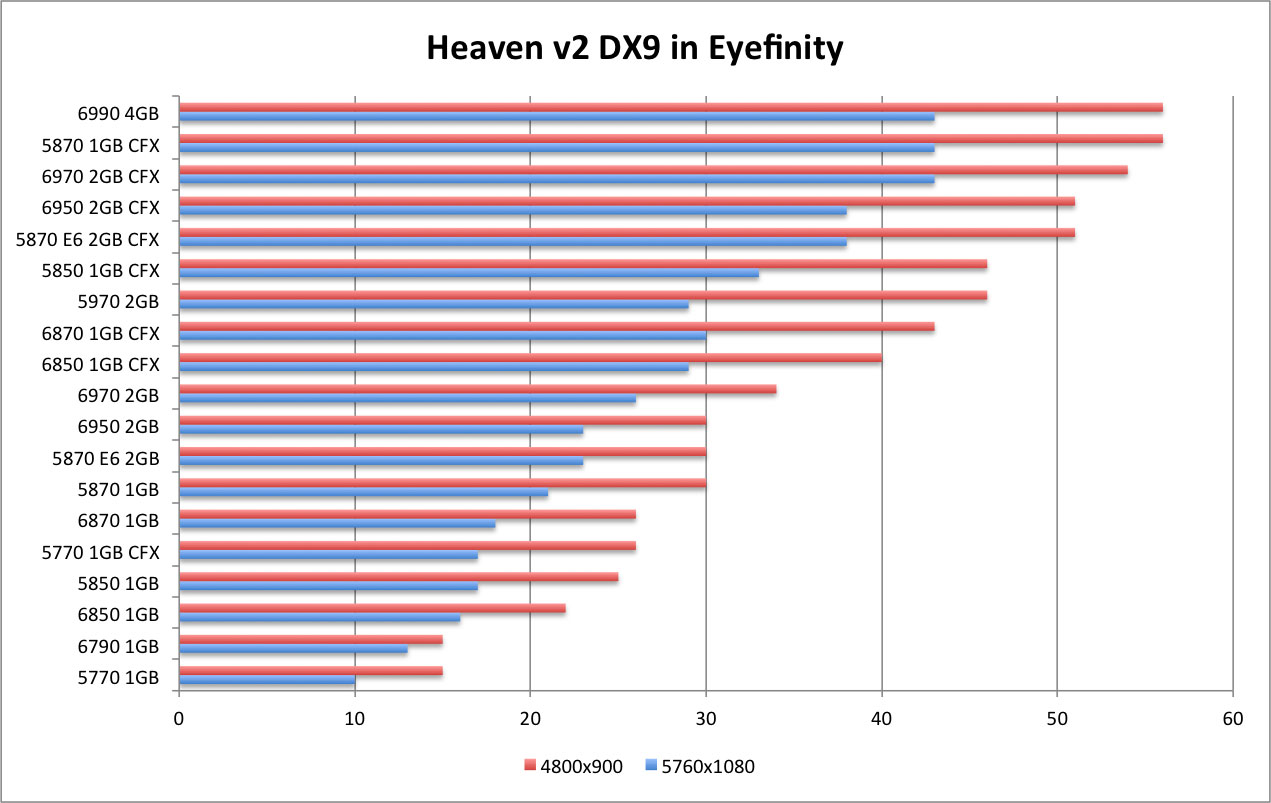

AMD Radeon 6790 Review - Heaven DX10
The Unigine Heaven Demo is unique in that it is the only demo which allows for the following components in one package.
- Synthetic Demo (i.e., a demo designed to "test" a system)
- Comparable tests of DX9, DX10 and DX11
- Is Hor+ (rather than limited to a few predefined aspect ratios)
The ability to compare DX9, DX10 and DX11 in the same environment allows for the unique ability to see how the different cards perform across these different comparable environments. Tessellation was set at Normal Mode.
The updated 2nd version of the Heaven demo offers more segments and more options. DX9 and DX10 runs are no match for any single 6800 or 6900 series card, with only the single 6800 series falling below 60fps. The DX11 run in more demanding in a single widescreen, requiring a 6900 series in CFX to pass 60fps (and pass it by a good margin). Single 6900 series cards also pass 30fps at either 1600x900 or 1920x1080.
Eyefinity is an obvious strain on any configuration. A 2GB card is required for Eyefinity in DX10 or DX11. No combination of cards will hit 60fps in DX9, though the high end configurations come close.
The HD 6790 will hit 30fps in single screen configurations, though Eyefinity brings a serious blow to performance. Eyefinity will only run at 3x1600x900 on the HD 6790, and even then only at very low frame rates.
The Heaven v2 Demo continues to be a powerhouse in bringing graphics cards to their knees.
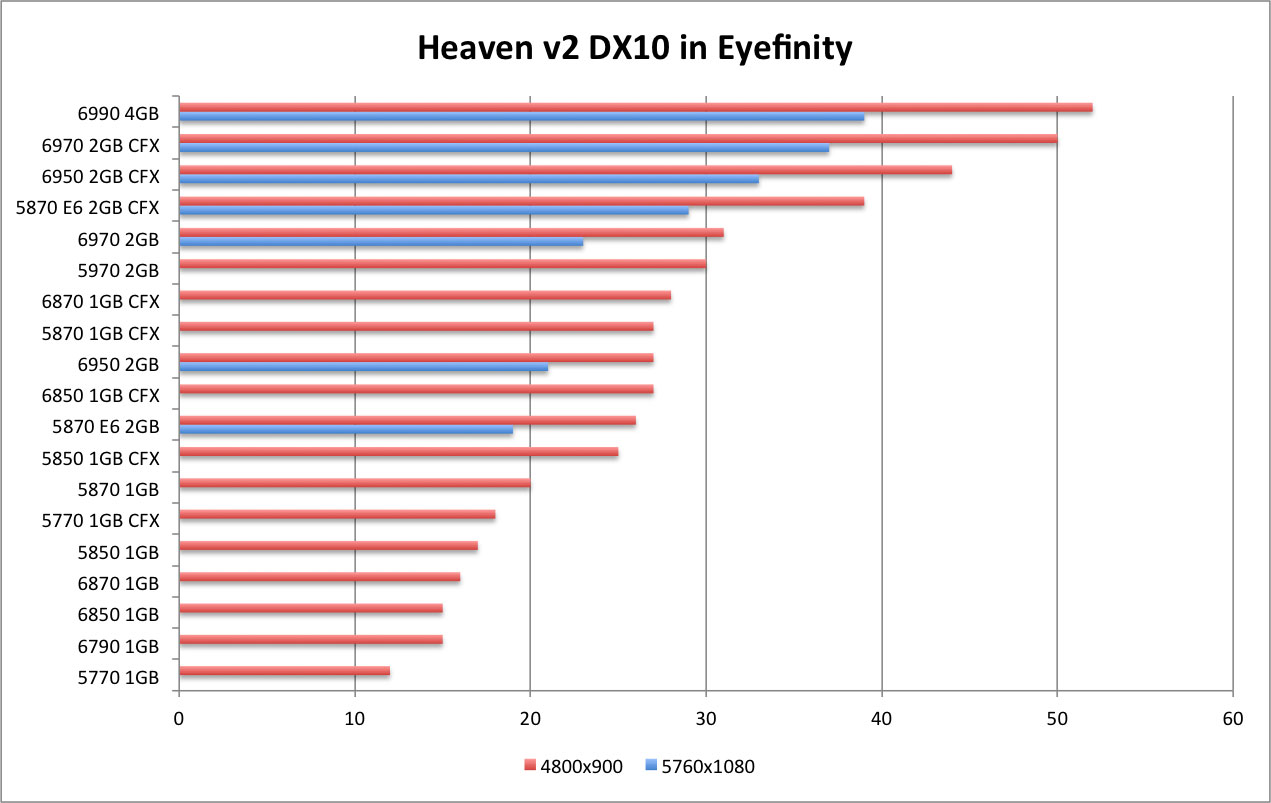
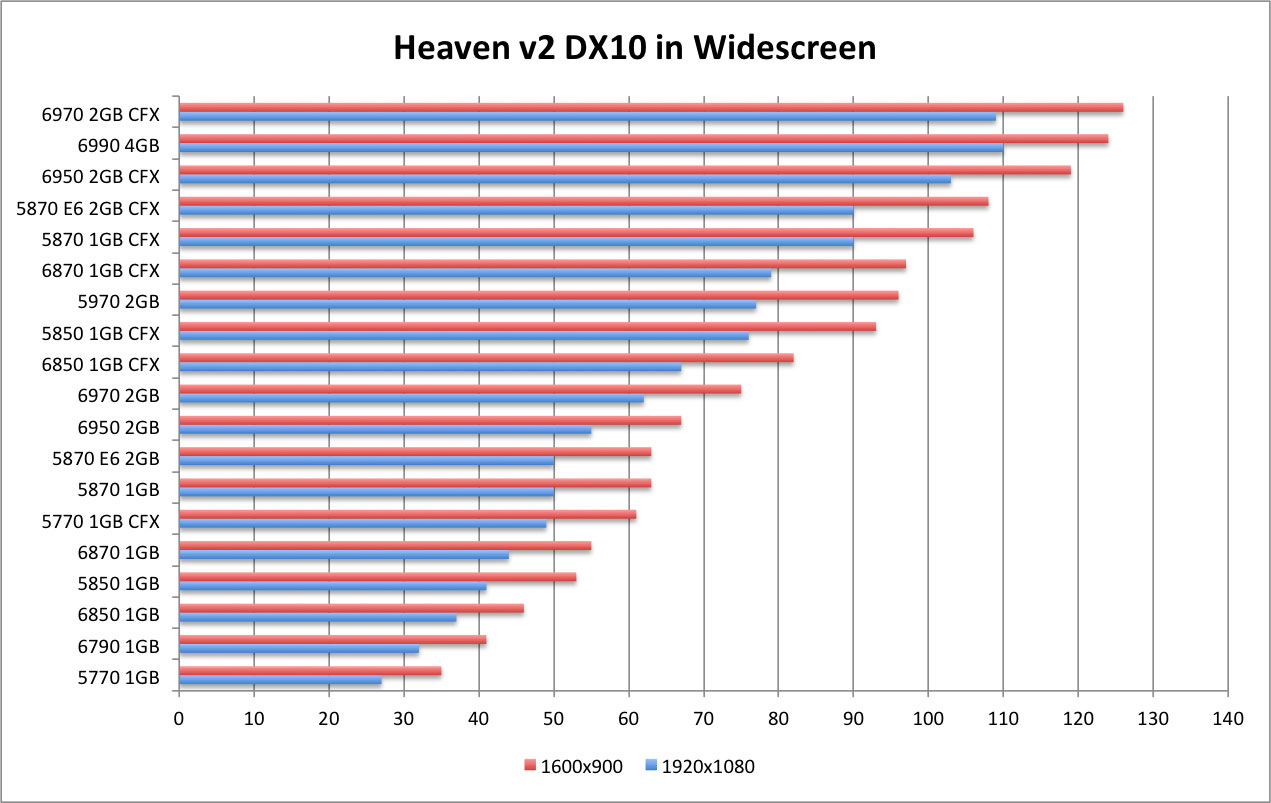
AMD Radeon 6790 Review - Heaven DX11
The Unigine Heaven Demo is unique in that it is the only demo which allows for the following components in one package.
- Synthetic Demo (i.e., a demo designed to "test" a system)
- Comparable tests of DX9, DX10 and DX11
- Is Hor+ (rather than limited to a few predefined aspect ratios)
The ability to compare DX9, DX10 and DX11 in the same environment allows for the unique ability to see how the different cards perform across these different comparable environments. Tessellation was set at Normal Mode.
The updated 2nd version of the Heaven demo offers more segments and more options. DX9 and DX10 runs are no match for any single 6800 or 6900 series card, with only the single 6800 series falling below 60fps. The DX11 run in more demanding in a single widescreen, requiring a 6900 series in CFX to pass 60fps (and pass it by a good margin). Single 6900 series cards also pass 30fps at either 1600x900 or 1920x1080.
Eyefinity is an obvious strain on any configuration. A 2GB card is required for Eyefinity in DX10 or DX11. No combination of cards will hit 60fps in DX9, though the high end configurations come close.
The HD 6790 won't 30fps in single screen configurations, though q drop in quality would hit that magical mark. Eyefinity brings an additional blow to performance. Eyefinity will only run at 3x1600x900 on the HD 6790, and even then only at very low frame rates.
The Heaven v2 Demo continues to be a powerhouse in bringing graphics cards to their knees.
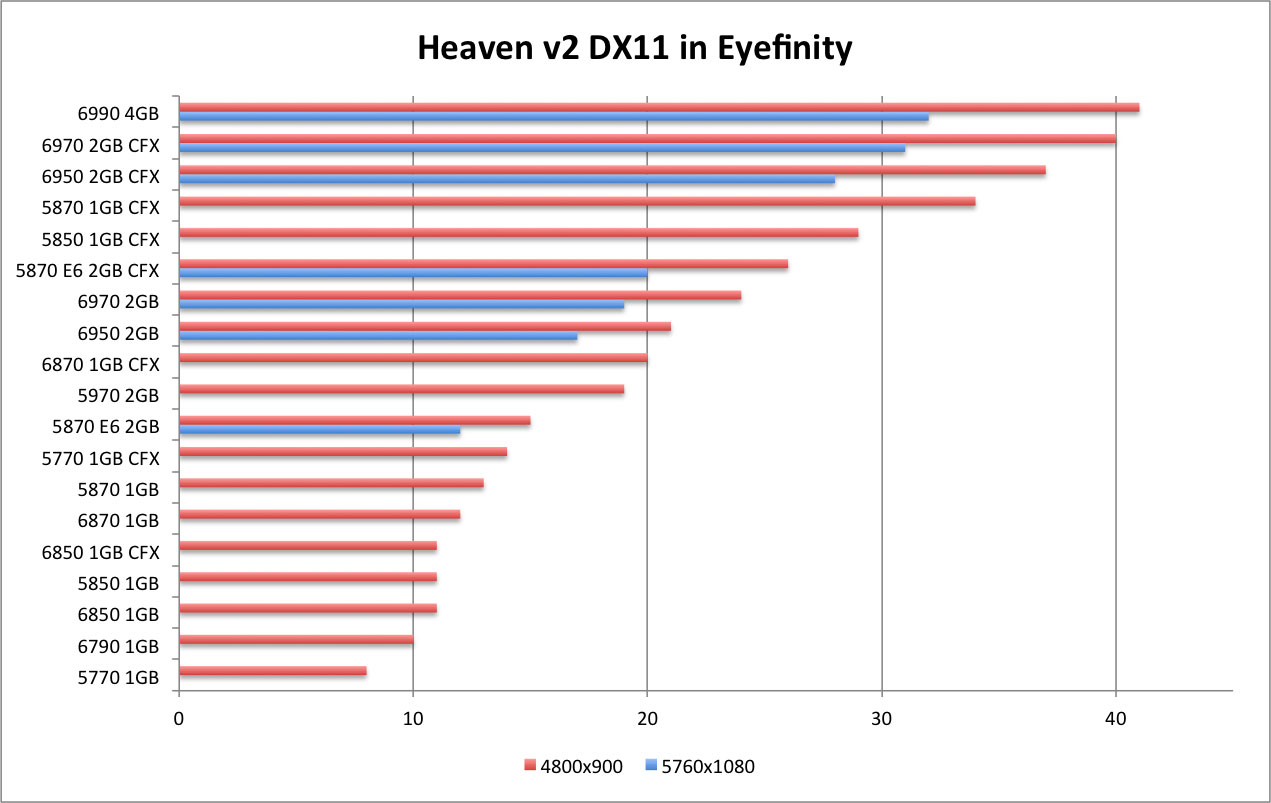
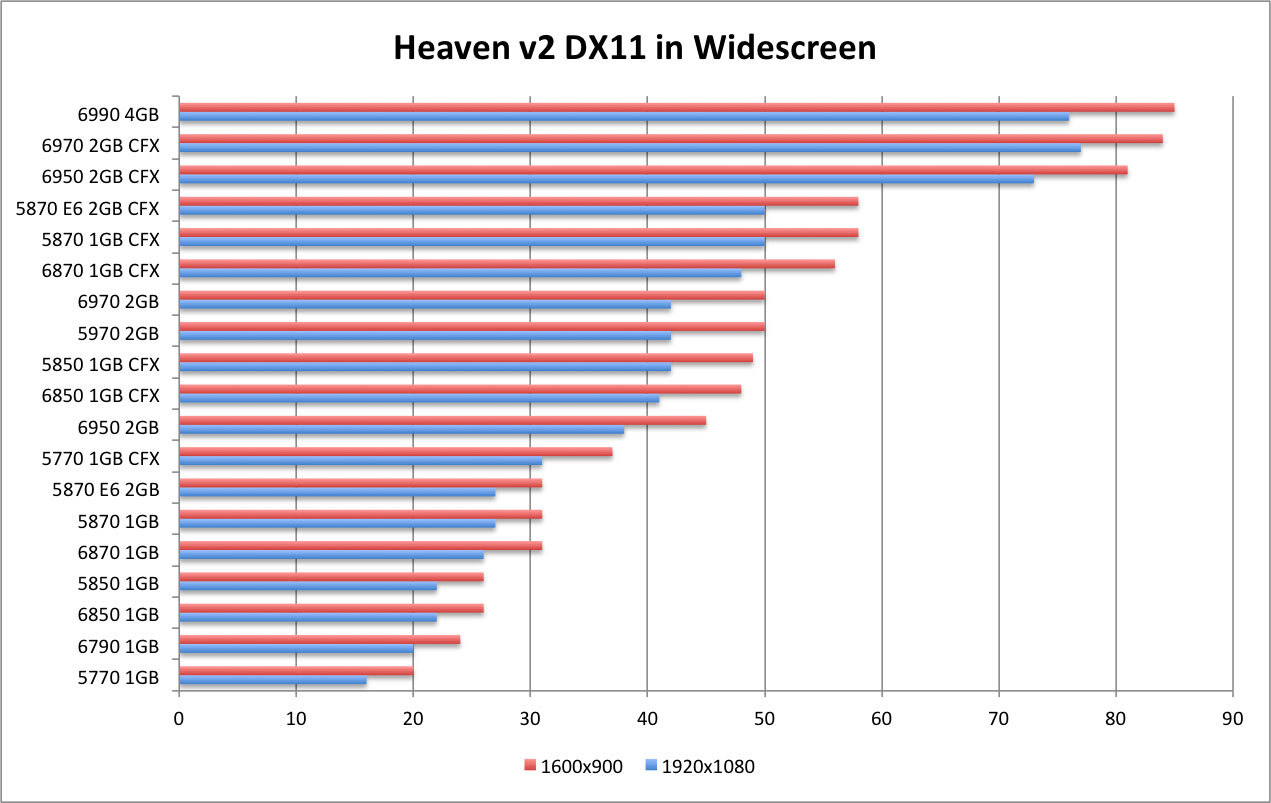
AMD Radeon 6790 Review - Just Cause 2
Just Cause 2 is the wildly popular sequal to the wildly popular Just Cause. You take control of protagonist Rico Rodriquez and rain down over the top destruction across a small desert island. The game is a free roaming title that offers literally limitless options to wreck havoc with your "hook shot" grapling device.
While the benchmark tool in the demo doesn't offer anything in the way of explosions or destruction, it does offer some beautiful scenery that is still quite demanding on multi-monitor environments.
The CFX configurations max out at 120fps for single widescreens, and top out at 60fps for Eyefinity. Single cards easily hit 60fps for widescreen and 30fps for Eyefinity. It's great to see a current, modern, and beautiful game performing this well across the whole range of cards and price points.
The HD 6790 blazes past 30fps on a single screen, and approaches 60fps at 1600x900. Similarly, the HD 6790 approaches 30fps at 3x1600x900. With slightly reduces settings, you could hit 60fps on a single screen and 30fps on Eyefinity.
One interesting thing to note about the Just Cause 2 demo. I first started testing with the demo benchmark. It only recognized 4GB of the RAM in my system. However, the benchmark in the full game recognizes all 12GB. I can't determine if the extra RAM provides any benefits, as the demos are different.
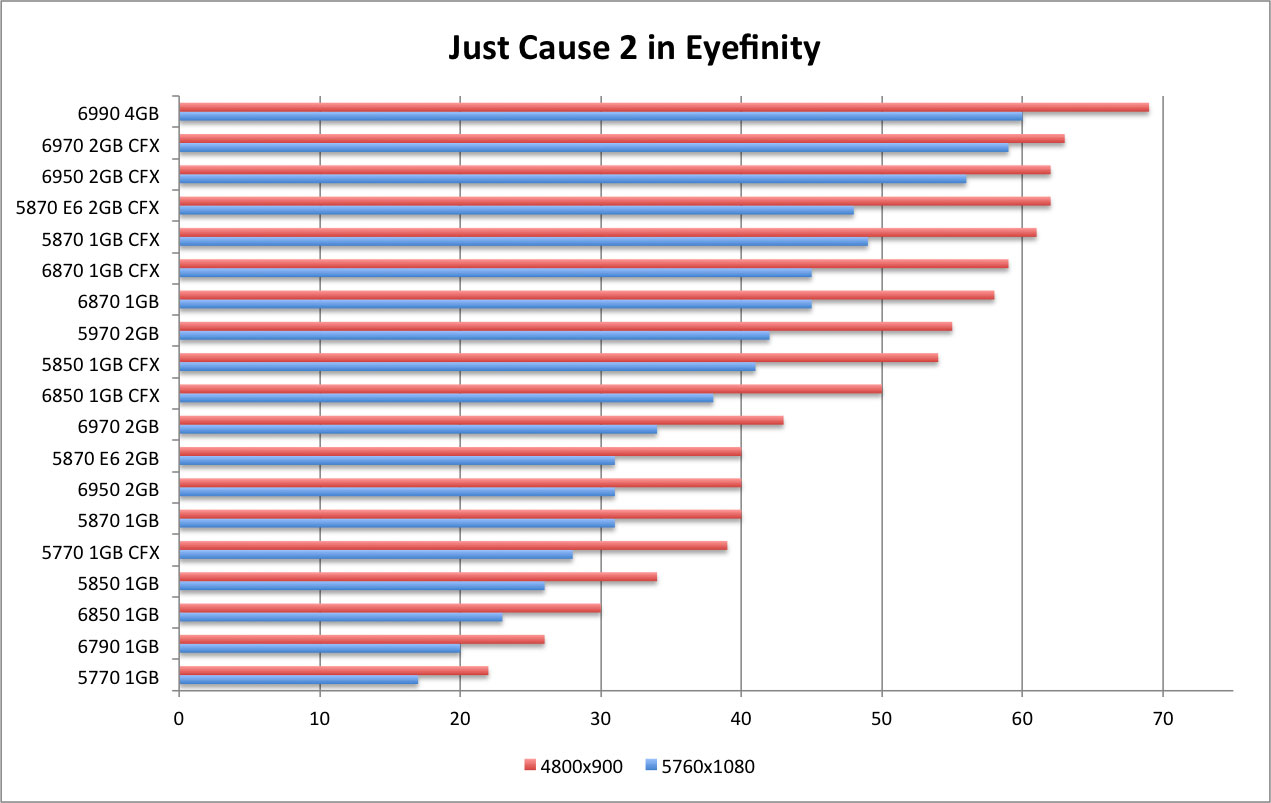
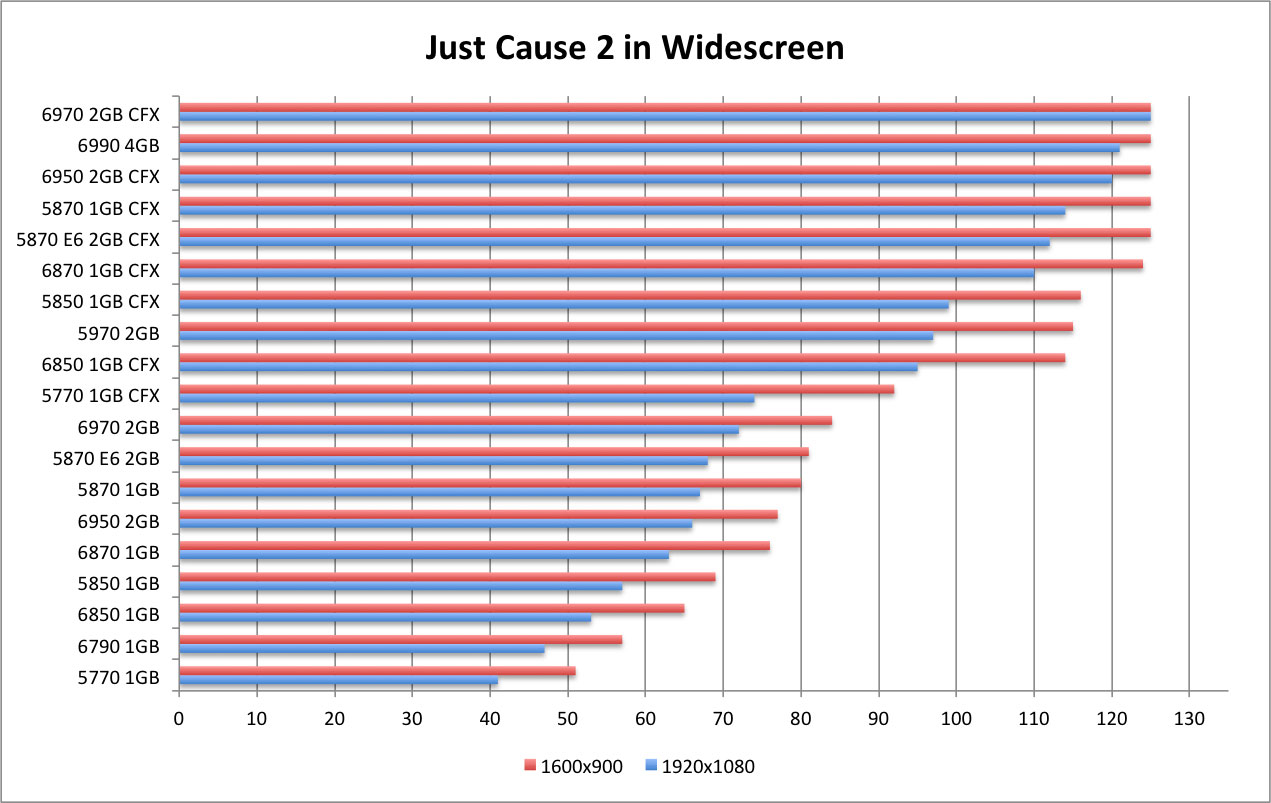
AMD Radeon 6790 Review - Mafia II
Mafia II is an open world "crime" title from 2K Games. It is the second game in the Mafia series. The demo comes with a built-in benchmark tool that offers both indoor and outdoor environments, various lighting effects and fire.
A single card won't quite hit 30fps in Eyefinity, but a CFX setup pushes past consistently. We see a CPU limit at about 70fps in widescreen. Mafia II proves to be quite a demanding benchmark for Eyefinity, as only CFX configurations can consistently cross 30fps in Eyefinity.
The HD 6790 pushes past 30fps in a single screen configuration. Eyefinity (at max settings) is challenging for any modern card on an Intel Core i7-920. Eyefinity is going to be a challenge for the HD 6790 - at any settings.
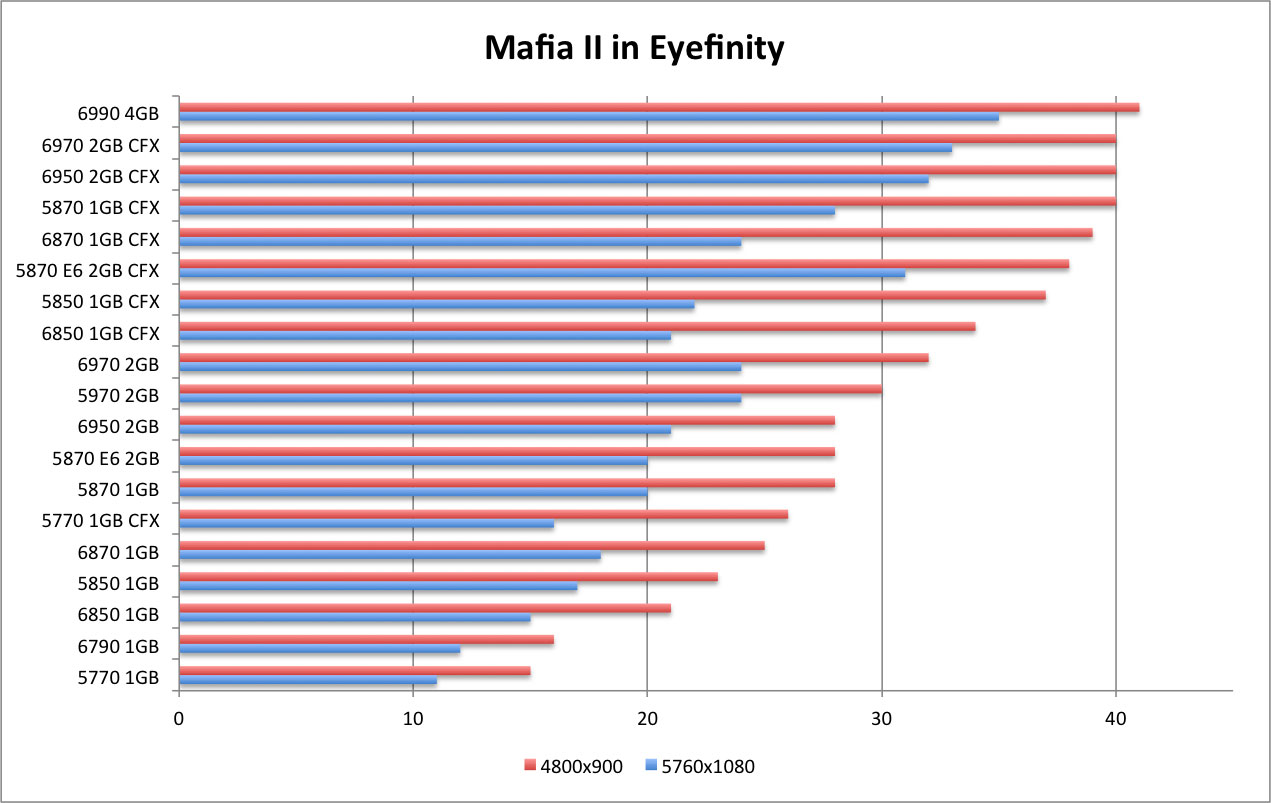

AMD Radeon 6790 Review - S.T.A.L.K.E.R.: Call of Pripyat
S.T.A.L.K.E.R.: Call of Pripyat
Prior to the game's release, the developer put out a benchmarking tool to test your system configuration. It offers a number of different options for utilizing DX9, 10 or 11 code paths. It also offers options for varying levels of HDAO and Shadow Quality. The demo itself isn't very pretty to look at (lots of dirt and dirt-colors), but it does put a beating on your system.
Like the Heaven demo, the demo basically will not run at 5760x1080 using 4xAA, with only 1GB of VRAM.
The new cards provide a noticeable performance jump over previous generations. Widescreen provides a steady performance curve for the current AMD product line. Mid-range cards can hit 30fps at max settings on a single widescreen, with the 2GB cards and CFX configurations passing 60fps.
Eyefinity provides to be a large challenge for any card. The HD 6790 hits around 30fps in a single screen, but Eyefinity isn't an option for this demanding title at DX11, max settings and 4xAA.
This benchmark covers all four parts of the demo:
- Daylight
- Night
- Rain
- Sun Shafts
AMD Radeon 6790 Review - S.T.A.L.K.E.R.: Call of Pripyat (Daylight)
Prior to the game's release, the developer put out a benchmarking tool to test your system configuration. It offers a number of different options for utilizing DX9, 10 or 11 code paths. It also offers options for varying levels of HDAO and Shadow Quality. The demo itself isn't very pretty to look at (lots of dirt and dirt-colors), but it does put a beating on your system.
Like the Heaven demo, the demo basically will not run at 5760x1080 using 4xAA, with only 1GB of VRAM.
The new cards provide a noticeable performance jump over previous generations. Widescreen provides a steady performance curve for the current AMD product line. Mid-range cards can hit 30fps at max settings on a single widescreen, with the 2GB cards and CFX configurations passing 60fps.
Eyefinity provides to be a large challenge for any card. The HD 6790 hits around 30fps in a single screen, but Eyefinity isn't an option for this demanding title at DX11, max settings and 4xAA.
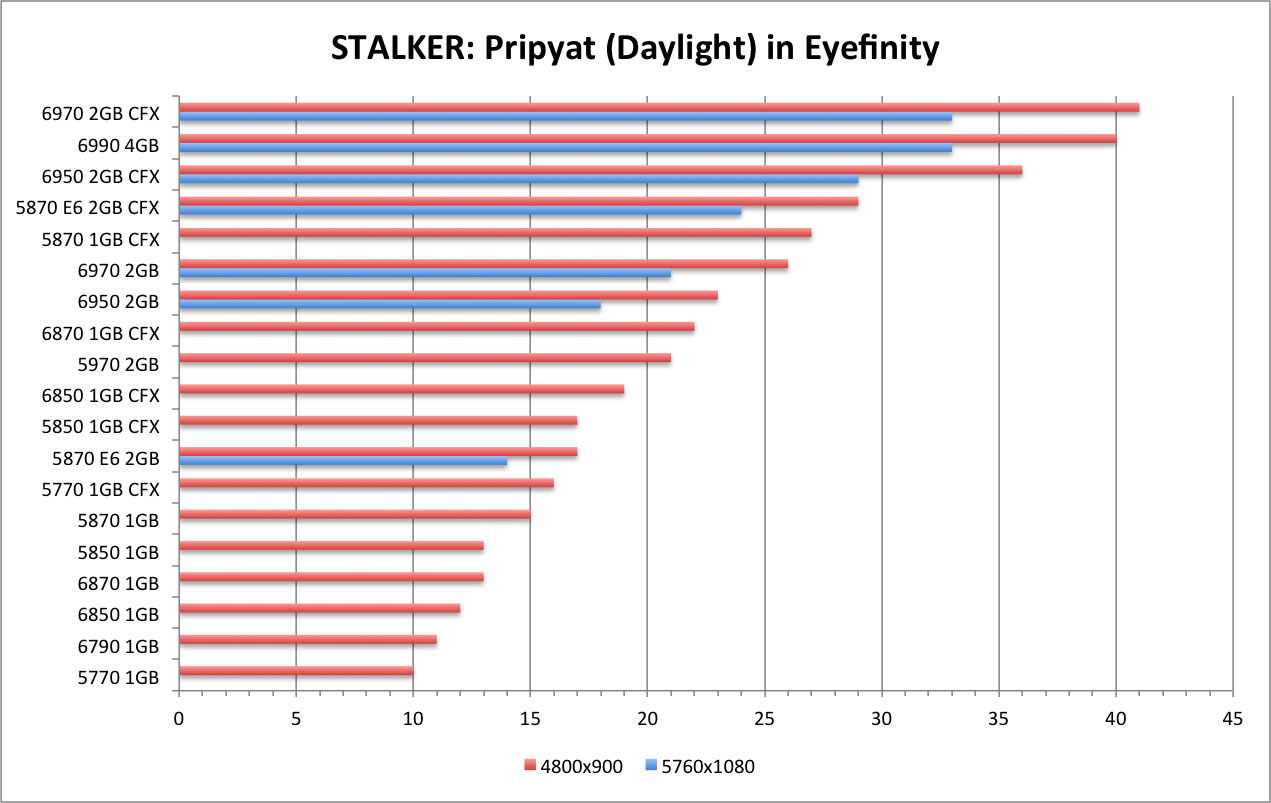
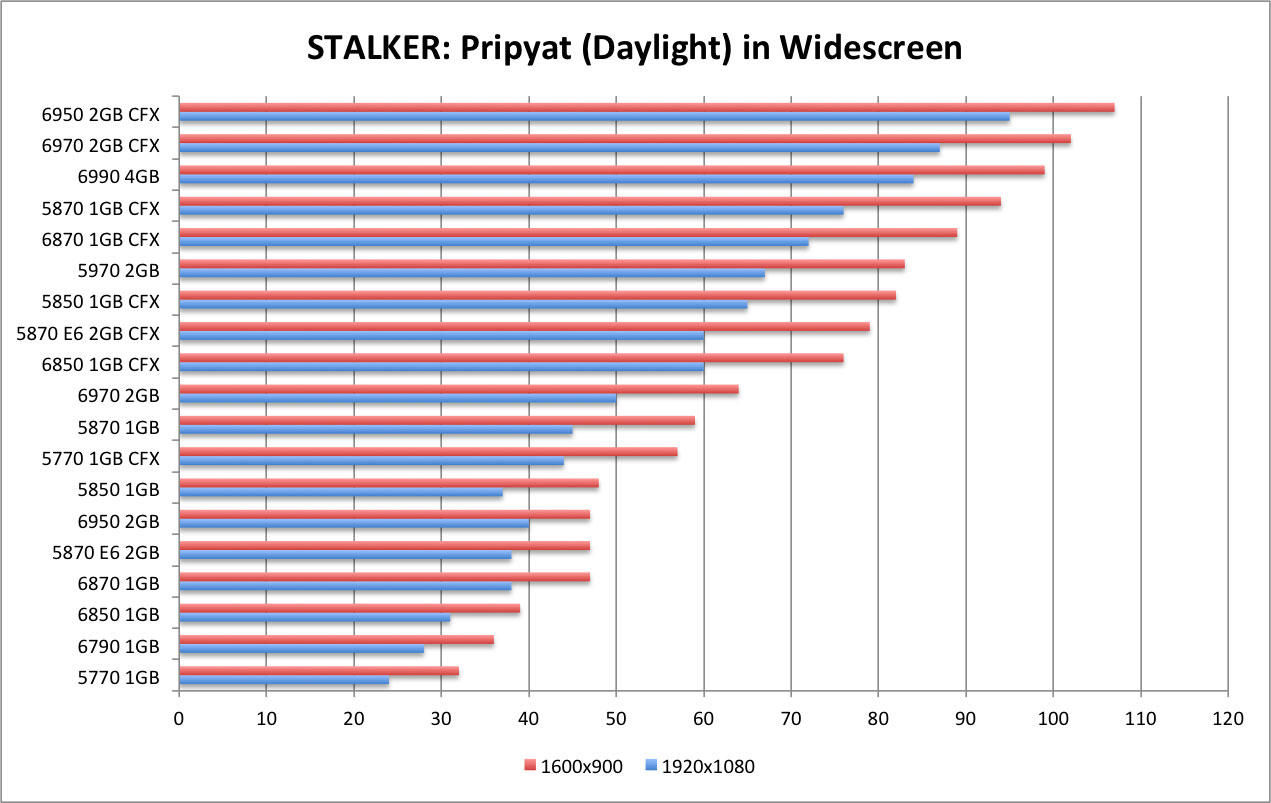
AMD Radeon 6790 Review - S.T.A.L.K.E.R.: Call of Pripyat (Night)
Prior to the game's release, the developer put out a benchmarking tool to test your system configuration. It offers a number of different options for utilizing DX9, 10 or 11 code paths. It also offers options for varying levels of HDAO and Shadow Quality. The demo itself isn't very pretty to look at (lots of dirt and dirt-colors), but it does put a beating on your system.
Like the Heaven demo, the demo basically will not run at 5760x1080 using 4xAA, with only 1GB of VRAM.
The new cards provide a noticeable performance jump over previous generations. Widescreen provides a steady performance curve for the current AMD product line. Mid-range cards can hit 30fps at max settings on a single widescreen, with the 2GB cards and CFX configurations passing 60fps.
Eyefinity provides to be a large challenge for any card. The HD 6790 hits around 30fps in a single screen, but Eyefinity isn't an option for this demanding title at DX11, max settings and 4xAA.
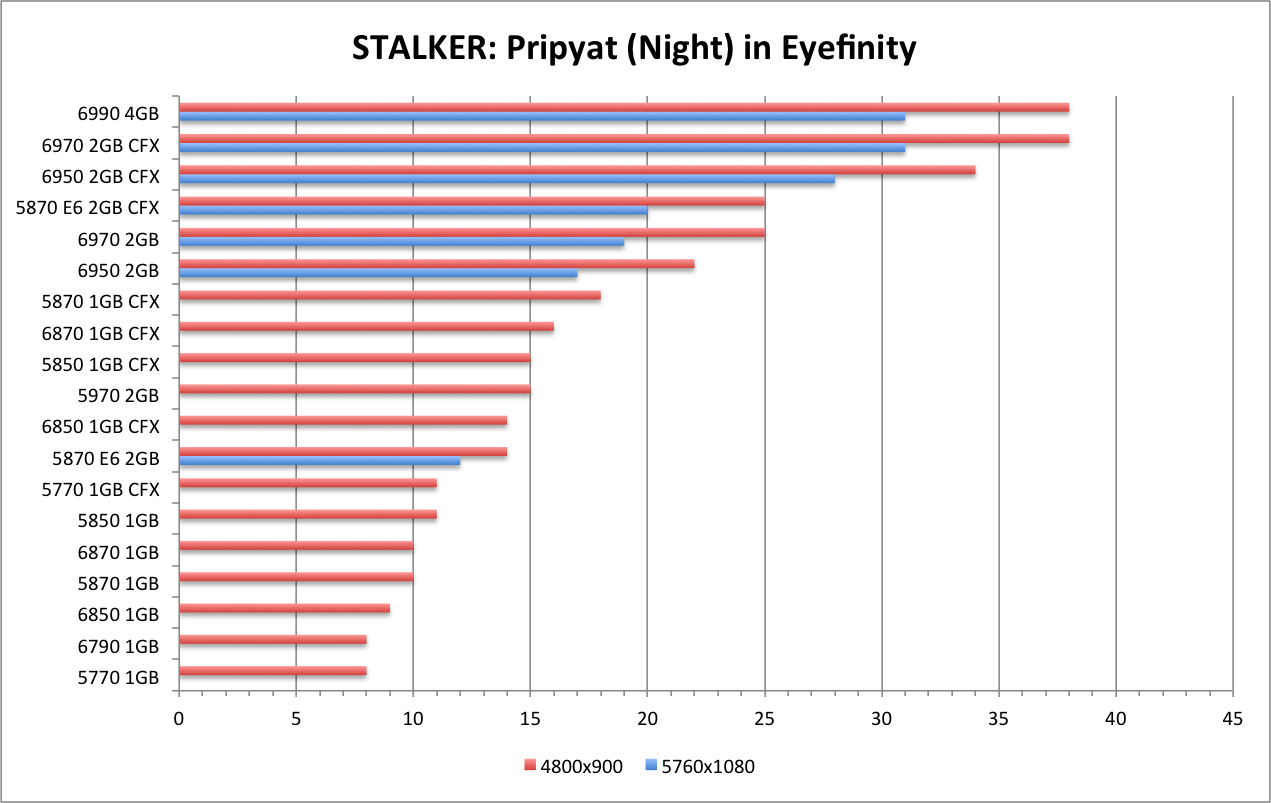
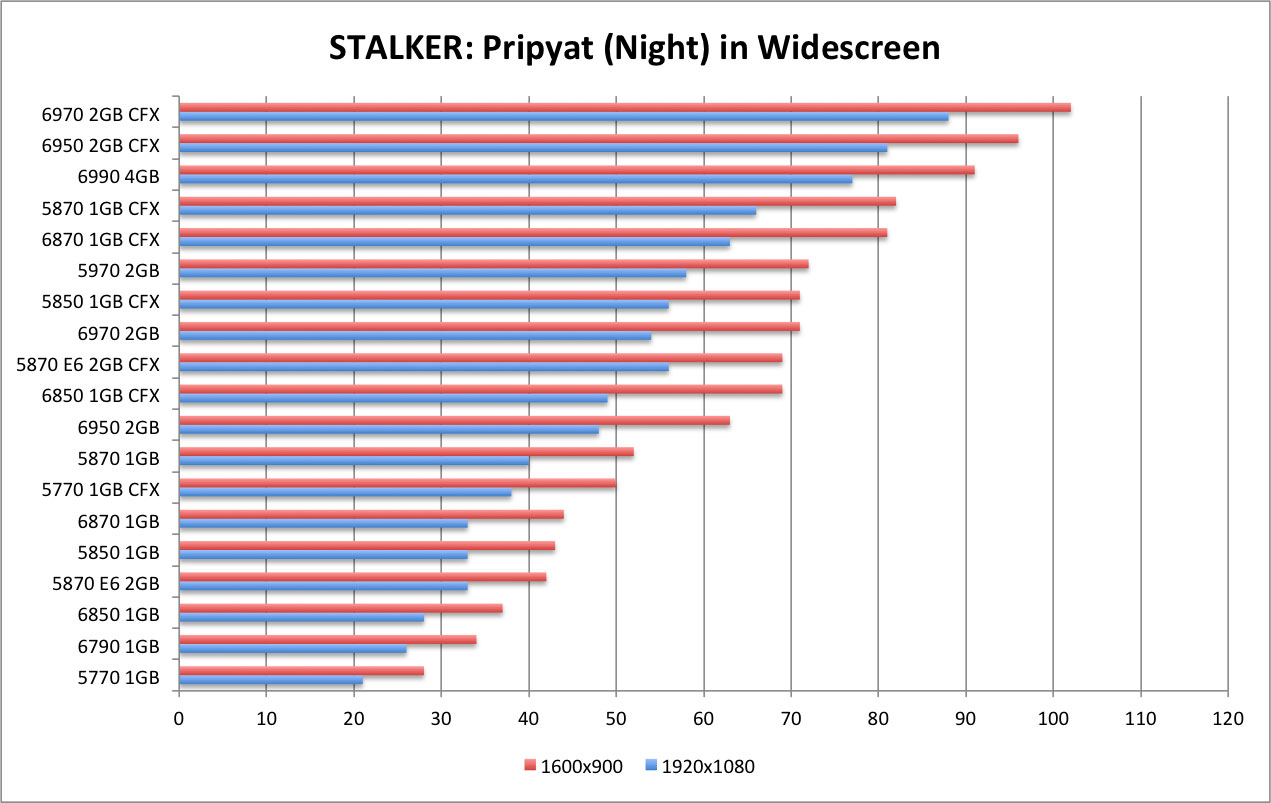
AMD Radeon 6790 Review - S.T.A.L.K.E.R.: Call of Pripyat (Rain)
Prior to the game's release, the developer put out a benchmarking tool to test your system configuration. It offers a number of different options for utilizing DX9, 10 or 11 code paths. It also offers options for varying levels of HDAO and Shadow Quality. The demo itself isn't very pretty to look at (lots of dirt and dirt-colors), but it does put a beating on your system.
Like the Heaven demo, the demo basically will not run at 5760x1080 using 4xAA, with only 1GB of VRAM.
The new cards provide a noticeable performance jump over previous generations. Widescreen provides a steady performance curve for the current AMD product line. Mid-range cards can hit 30fps at max settings on a single widescreen, with the 2GB cards and CFX configurations passing 60fps.
Eyefinity provides to be a large challenge for any card. The HD 6790 hits around 30fps in a single screen, but Eyefinity isn't an option for this demanding title at DX11, max settings and 4xAA.
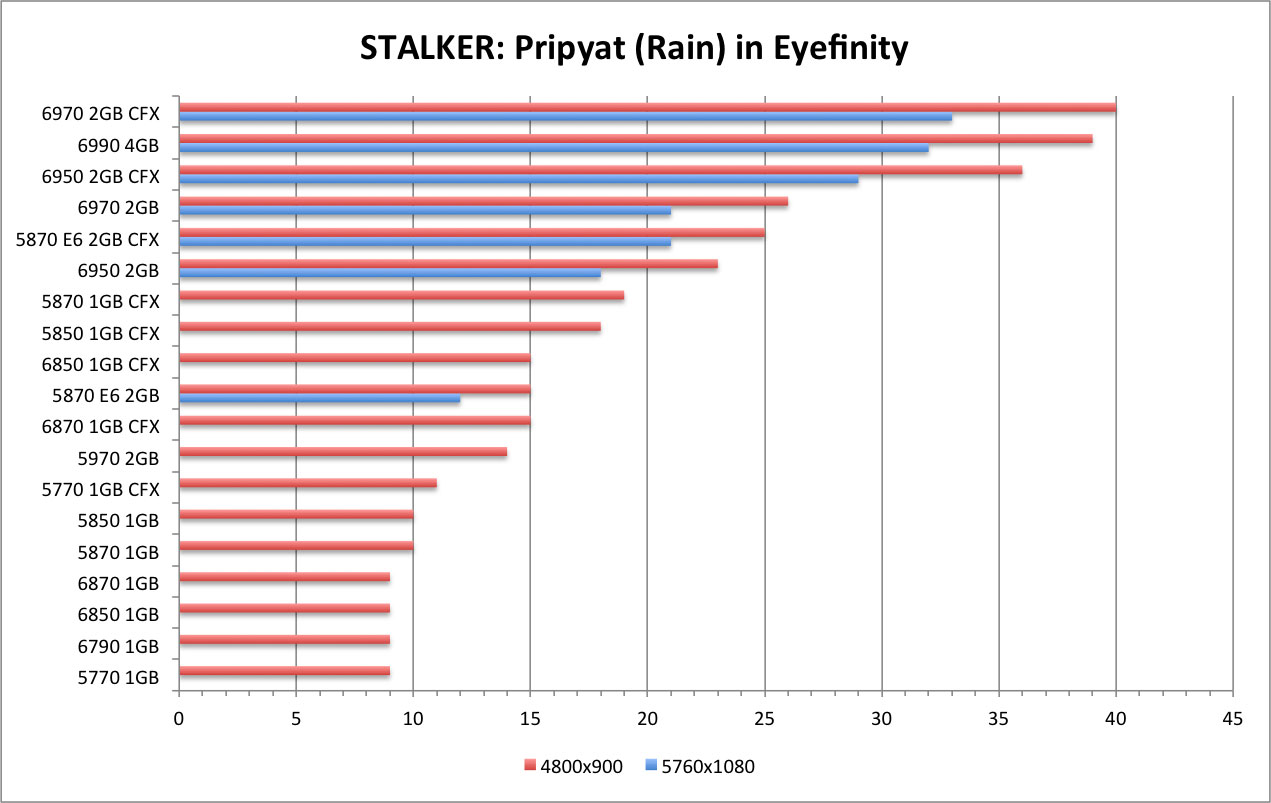
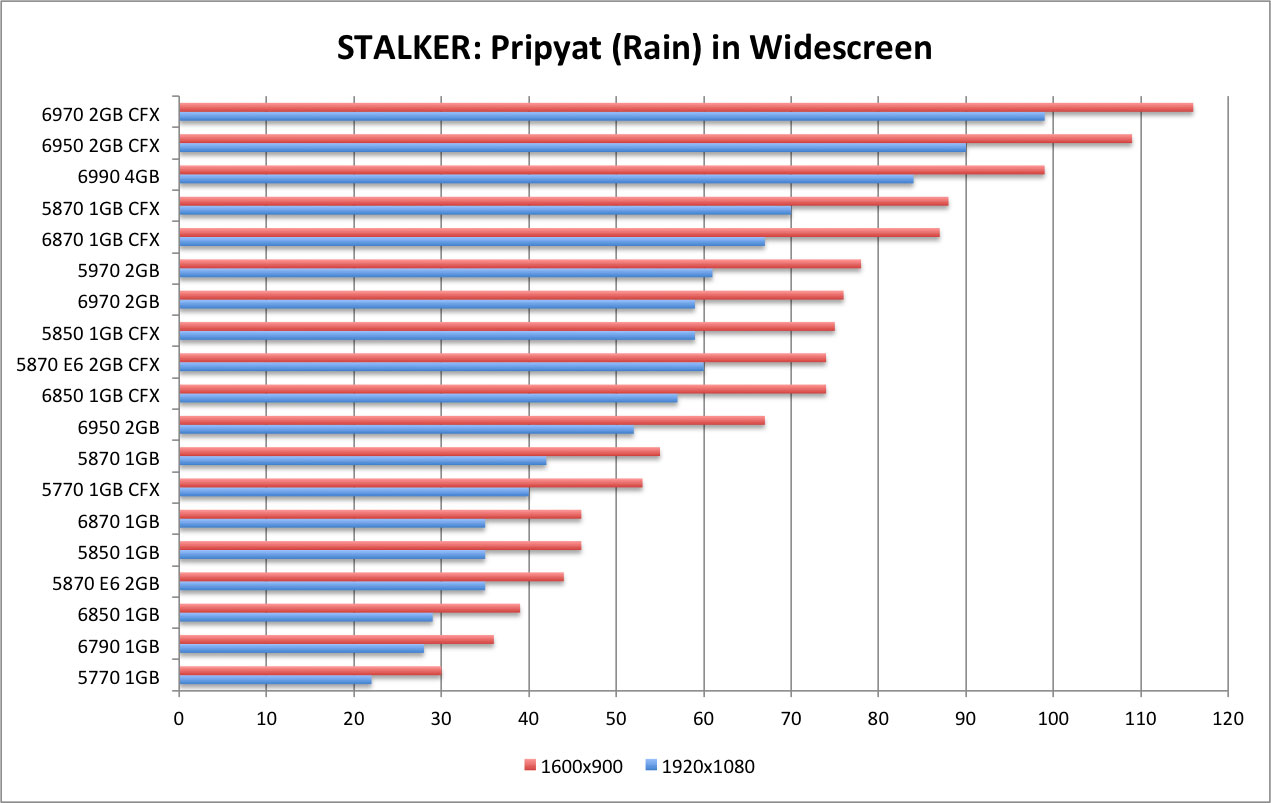
AMD Radeon 6790 Review - S.T.A.L.K.E.R.: Call of Pripyat (Sun Shafts)
Prior to the game's release, the developer put out a benchmarking tool to test your system configuration. It offers a number of different options for utilizing DX9, 10 or 11 code paths. It also offers options for varying levels of HDAO and Shadow Quality. The demo itself isn't very pretty to look at (lots of dirt and dirt-colors), but it does put a beating on your system.
Like the Heaven demo, the demo basically will not run at 5760x1080 using 4xAA, with only 1GB of VRAM.
The new cards provide a noticeable performance jump over previous generations. Widescreen provides a steady performance curve for the current AMD product line. Mid-range cards can hit 30fps at max settings on a single widescreen, with the 2GB cards and CFX configurations passing 60fps.
Eyefinity provides to be a large challenge for any card. The HD 6790 hits around 30fps in a single screen, but Eyefinity isn't an option for this demanding title at DX11, max settings and 4xAA.


| Attachment | Size |
|---|---|
| 6790-STALKERSun-EF.jpg | 133.1 KB |
| 6790-STALKERSun-WS.jpg | 167.55 KB |